![]()
![]()
![]()
Use LEFT and RIGHT arrow keys to navigate between flashcards;
Use UP and DOWN arrow keys to flip the card;
H to show hint;
A reads text to speech;
146 Cards in this Set
- Front
- Back
|
Schizophrenia prevalence: As a rule of thumb, the figure of ________ case of schizophrenia per 100 life time incidence seems a relatively good estimate of the size of the pool. |
As a rule of thumb, the figure of ________ case of schizophrenia per 100 life time incidence seems a relatively good estimate of the size of the pool. One in 100. |
|
|
The continuum view of schizophrenia argues that: |
Schizophrenia it is a fairly vague term used to classify a set of symptoms, and is not in itself, a diagnostic category. Psychosis is often discussed as if it is a well defined unitary psychological concept. Each symptom definition has its own internal ambiguities and inconsistencies. |
|
|
The continuum view of schizophrenia traditionally links schizophrenia to (three things) |
1. Schizophrenia spectrum disorders 2. Affective disorders 3. ‘Organic syndrome’ disorders (commonly dementia) |
|
|
The continuum view of schizophrenia argues that the illness may arise after almost any sort of illness, injury or drug use. What are some Pubmed attributions for the illness? |
AIDS, intensive care, malaria, leprosy, mumps, steroids, flu, diving, painting. |
|
|
What are the three components of the schizophrenia spectrum? |
1. Isolated symptoms 2. Prodromal symptoms 3. Schizophrenia |
|
|
Prevalence of schizophrenia in MZ twins? |
near 60% |
|
|
Susceptibility genes for schizophrenia include (6): |
NRG1 DTNBP1 DISC1 G30/DAO, G72/DAOA COMT |
|
|
Psychosis does not equal _____________? |
Psychosis does not equal schizophrenia. However, the diagnosis of schizophrenia, relies on the presence of psychotic symptoms. This has confused the picture, as many studies of ‘psychosis’ are actually on schizophrenia-related psychosis. |
|
|
Psychosis vs Schizophrenia. Schizophrenia seems to involve specific neuropsychological deficits __________ _______ _________those associated with the presence of psychosis per se (Tsuang et al, 2000). |
Schizophrenia seems to involve specific neuropsychological deficits above and beyond those associated with the presence of psychosis per se (Tsuang et al, 2000). |
|
|
Traditionally, psychosis has been seen as a _________ _______ ___________ from normal mental functioning. |
Traditionally, psychosis has been seen as a QUALITATIVELY DIFFERENT STATE from normal mental functioning. It is seen as a disorder or pathological in nature. This review relies on: - Symptom factors such as intrusiveness, frequency and co-morbidity. - Personal and social factors such as coping, illness behaviour, societal tolerance, resultant disability. |
|
|
Predictors of outcome in schizophrenia: Demographic: Good outcome and bad outcomes?
|
Good outcome: Female Married
Poor outcome: Male Single |
|
|
Predictors of outcome in schizophrenia: Genetic: Good outcome and bad outcomes? |
Good outcome: Family history of mood disorder Bad outcome: Family history of schizophrenia |
|
|
Predictors of outcome in schizophrenia: Onset: Good outcome and bad outcomes? |
Good outcome: Good premorbid adjustment Acute onset Life event at onset Prompt treatment Poor outcome: Schizoid traits Slow onset Long duration of untreated psychosis Onset under 17 years old |
|
|
Predictors of outcome in schizophrenia: Symptoms: Good outcome and bad outcomes? |
Good outcome: Affective symptoms Poor outcome: Negative symptoms Obsessions Bizarre delusions Poor insight |
|
|
Predictors of outcome in schizophrenia: Psychosocial: Good outcome and bad outcomes? |
Good outcome: Good response to treatment Poor outcome: High expressed emotion Substance misuse Poor adherence to treatment |
|
|
Schizophrenia: The positive symptoms Define Hallucination: |
Sensory experiences in the absence of any stimulation from the environment e.g., audible thoughts/voices arguing/voices commenting. |
|
|
Schizophrenia: The positive symptoms Define Delusion: |
Holding a belief that the rest of society would generally disagree with or view as misinterpretations of reality. |
|
|
Schizophrenia: The positive symptoms Define bizarre behavior: |
The practice of unusual or uncharacteristic behaviors or rituals such as aggressiveness, or saving body products. |
|
|
Schizophrenia: The positive symptoms Define thought disorder: |
Problem with the form of thought. Includes such features as: incoherence, neologism (generation of non-words), loosening of association, clang associations, poverty of speech, perseveration and thought blocking. |
|
|
Schizophrenia: The negative symptoms Define flattening of affect: |
Virtually no stimulus can elicit an emotional response (blunting and apathy). These individuals may also show inappropriate affect where the response that they make is out of context with the usually accepted response. |
|
|
Schizophrenia: The negative symptoms Define alogia: |
Decease in the flow and spontaneity of speech |
|
|
Schizophrenia: The negative symptoms Define avolition: |
Decease in the ability to motivate oneself or get things started. |
|
|
Schizophrenia: The negative symptoms Define anhedonia: |
Inability to be able to feel pleasure in any activity |
|
|
Schizophrenia: The negative symptoms Define attention deficit: |
Inability to attend and track mental operations. |
|
|
What are Schneider's first rank (schizophrenia) symptoms. (6) |
1. Thought insertion, withdrawal, or broadcasting. 2. Passivity experiences 3. Delusional perception 4. Echo de la pensee 5. Running commentary 6. Third-person auditory hallucinations |
|
|
Schneider's first rank (schizophrenia) symptoms Thought insertion, withdrawal, or broadcasting = |
The experience of one's thoughts being put into or taken out of one's head, or broadcast to others. Collectively known as "thought interference". |
|
|
Schneider's first rank (schizophrenia) symptoms Passivity experiences = |
Experience that one's thoughts or actions are physically being controlled by an external force: "made actions" |
|
|
Schneider's first rank (schizophrenia) symptoms Delusional perception = |
A normal perception followed suddenly by a seemingly unrelated, fulled formed delusion (rare) |
|
|
Schneider's first rank (schizophrenia) symptoms Echo de la pensee = |
Hallucination of a voice repeating one's own thoughts |
|
|
Schneider's first rank (schizophrenia) symptoms Running commentary = |
Hallucination describing one's current actions |
|
|
Schneider's first rank (schizophrenia) symptoms Third-person auditory hallucinations = |
Voices describing patient as "he" or "she" |
|
|
The key events that led to the development of the dopamine theory of schizophrenia. What happened in the 1950s? |
The anti schizophrenic effects of both chloropmazine and reserpine were observed to be related to parkinsonian side effects. The brains of recently deceased Parkinson's patients were found to have little dopamine |
|
|
The key events that led to the development of the dopamine theory of schizophrenia. What happened in the 1960 and 1970s? |
It was hypothesized that schizophrenia is caused by excessive activity at dopaminergic synapses The dopamine-receptor binding of phenthiazines, but not butyrophenones, was found to be roughly correlated with their anti-schizophrenic potency. The binding of anti-schizophrenic drugs to D2 receptors was found to be highly correlated with their anti-schizophrenic potency |
|
|
The key events that led to the development of the dopamine theory of schizophrenia. Currently? |
The D2 receptor modification of dopamine theory is the dominant theory of schizophrenia: schizophrenia is thought to be produced by excessive activity at D2 receptors. |
|
|
The key events that led to the development of the dopamine theory of schizophrenia. Future? |
The recent discovery of D3 receptors is likely to lead to major revisions of the dopamine theory. |
|
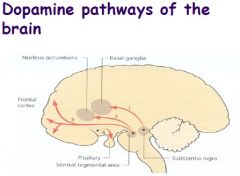
Name the four dopamine pathways of the brain |
1. Nigrostriatal 2. Mesolimbic 3. Mesocortical 4. Tuberohypophyseal |
|
|
The dopamine hypothesis of schizophrenia (overactivity of one of the three dopamine transmitter systems in brain; antipsychotics work by inhibiting dopamine neurotransmission) is.... |
over simplistic. |
|
|
Positive symptoms are due to increased activity in the ________________ ______ pathway. |
Positive symptoms are due to increased activity in the MESOLIMBIC DA pathway. |
|
|
Negative symptoms are due to decreased activity in the ______________ pathway. |
Negative symptoms are due to decreased activity in the MESOCORTICAL pathway. |
|
|
Patients with schizophrenia show impairments consistent with impairment in __________ __________ ___________. |
Patients with schizophrenia show impairments consistent with impairment in REWARD SYSTEM FUNCTION. |
|
|
Impairment in REWARD SYSTEM FUNCTION results in what three things? |
1. Anhedonia 2. Decreased motivation 3. Failure to use feedback to enhance goal directed behaviour |
|
|
What neurotransmitter may be involved in both negative and positive symptoms and cognitive impairments in schizophrenia? |
GLUTAMATE may be involved in both negative and positive symptoms and cognitive impairments |
|
|
_____________ and _________-________ changes are considered important in the cognitive changes. |
Cholinergic and GABA-ergic changes are considered important in the cognitive changes. |
|
|
Main arguments for the dopamine hypothesis? (5) |
1. Amphetamine induced psychosis produces a schizophrenia like illness. 2. Amphetamines exacerbate schizophrenia 3. Drugs that block dopamine receptors are antipsychotic in relationship to their blocking potential 4. Post-mortem and endocrine studies 5. Animal models of dopamine agonism resemble psychosis, and are reversed by dopamine blocking agents. |
|
|
Main arguments against the dopamine hypothesis? (3) |
1. time course between administration of a dopamine blocker and clinical response 2. Dopamine agonist have an inconsistent effect on psychosis 3. Direct evidence of decreased dopamine activity is poor. |
|
|
Two "types" of schizophrenia: Type II is characterized by: (8) |
1. Minimal genetic contribution 2. Negative symptoms 3. Abnormal EEG and atrophy on CT 4. Impaired cognition 5. Abnormal involuntary movements (soft neurological signs) 6. Structural brain changes 7. Decreased CCK 8. Poor response to medication |
|
|
Two "types" of schizophrenia: Type I is characterized by: (6) |
1. Big genetic contribution 2. Positive symptoms 3. Normal EEG and no atrophy on CT 4. Normal cognitive function 5. Good response to medications 6. Increased DA receptors |
|
|
Liddle's three syndrome model of schizophrenia. What characterizes the three syndromes? |
1. Hallucinations and delusions. 2. Negative symptoms 3. Behavioral disorganization |
|
|
Liddle's three syndrome model of schizophrenia. Four negative symptoms of schizophrenia? |
1. Alogia 2. Affect flattening 3. Avolition 4. Anhedonia |
|
|
Liddle's three syndrome model of schizophrenia. Three behavioral disorganization symptoms of schizophrenia? |
1. Positive formal thought disorder 2. Inappropriate affect 3. Bizarre behavior |
|
|
Liddle’s three syndromes: A psychomotor poverty syndrome is much like.... |
A psychomotor poverty syndrome much like Andreasen’s negative symptoms, |
|
|
Liddle’s three syndromes: A disorganisation syndrome consisting of ..... (3) |
1. formal thought disorder 2. inappropriate affect 3. poverty of content of speech |
|
|
Liddle’s three syndromes: A reality distortion syndrome consisting of ..... (2) |
A reality distortion syndrome consisting of delusional and hallucinatory symptoms |
|
|
Imaging and EEG characteristics: On CT scans, schizophrenia patients show display abnormalities. Where? |
Ventricular dilatation. |
|
|
Greater ventricular dilatation is associated with....? |
poor social adjustment |
|
|
In schiophrenia imaging there is a progressive loss of _____ ________ over time. |
grey matter. |
|
|
What are the clinical features that have been associated with the ventricular enlargement? |
1. Early brain damage or birth complications 2. Poorer premorbid adjustment 3. More negative symptoms 4. Less positive symptoms 5. Cognitive decline 6. Poorer response to treatment 7. More minor neurological signs 8. Decreased CSF-HVA |
|
|
The clinical features that have been associated with the ventricular enlargement aren't directly attributable to institutionalization as.. |
They occur in the young, and in twins |
|
|
It is now certain that schizophrenia involves structural changes to what three brain regions? |
1. The PFC 2. Corpus callosum 3. Ventricles. |
|
|
A recent study by Pantelis et al (2003) showed that ____________ ___ __ involves grey matter changes. |
A recent study by Pantelis et al (2003) showed that psychosis per se involves grey matter changes. - Baseline MRI scan of 75 people with prodromal signs of psychosis. - 23 developed frank psychosis at 1 year follow up, baseline scans were compared. - Rescanned 10 individuals with frank psychosis and compared re-scan with baseline. |
|
|
The prodrome: Prodromes may self-perceive subtle _____________ and ____________ aberrations predictive of later psychosis in schizophrenia. |
Prodromes may self-perceive subtle cognitive and perceptual aberrations predictive of later psychosis in schizophrenia. |
|
|
Hambrecht et al (2002) prodromes who subjectively experience cognitive deficits (perception, cognition, stress reactivity) may also be characterised by.... |
objectively measurable disturbances. |
|
|
What impairments are common in the prodrome phase? |
1. Attention 2. Verbal/visual memory 3. Verbal fluency Although these were significantly less severe than patients who had already developed schizophrenia |
|
|
What are the areas of grey matter reduction in psychosis? |
Right temporal inferior frontal cortex cingulate left medial temporal left orbitofrontal cingulate cerebellum |
|
|
How big are the changes in brain structure in schizophrenia. Total ventricular volume? |
Increased by 20-30% |
|
|
How big are the changes in brain structure in schizophrenia. Total cranial and brain volume? |
Decreased 2 - 4 % |
|
|
How big are the changes in brain structure in schizophrenia. Heteromodal association cortex (prefrontal superior temporal, inferior parietal cortices) |
Decreased 5 - 10% |
|
|
How big are the changes in brain structure in schizophrenia. Medial temporal lobe (e.g., hippocampus) |
Decreased 4 - 10% |
|
|
How big are the changes in brain structure in schizophrenia. Thalamus |
Decreased 5 - 10% |
|
|
In schizophrenia, the cingulate is particularly |
asymmetric. |
|
|
____________ ____________ of the hippocampus in long-term schizophrenia is common |
Cellular Disarray of the hippocampus in long-term schizophrenia is common |
|
|
Atrophy of what brain structure is common in schizophrenia? |
Hippocampas |
|
|
To summarize… In short, both sides of the brain or their relationship to each other, ...... |
In short, both sides of the brain or their relationship to each other, the cortex and the subcortex, the temporal, frontal and parietal lobes, and either overactivation or underactivation of a combination of these have been implicated in the pathogenesis of schizophrenia. |
|
|
A deficit in what cognitive domain has been consistent identified in patients with schizophrenia? |
Attention deficits have been consistently identified in patients with schizophrenia using a range of assessment techniques. |
|
|
Subgroups of patients with schizophrenia differ in their abilities in what cognitive domain? |
Attentional abilities. |
|
|
Non-paranoid and negative state patients with schizophrenia demonstrate deficits consistent with reduced ___________ and _____________. |
Non-paranoid and negative state patients with schizophrenia demonstrate deficits consistent with reduced AROUSAL and DISTRACTABILITY. |
|
|
Paranoid and positive state patients with schizophrenia may demonstrate performances better than normals in what cognitive domain? |
Attention |
|
|
There is evidence of lateralised deficits in the disengagement and redirection of _________ __________in schizophrenia. |
There is also evidence of lateralised deficits in the disengagement and redirection of VISUAL ATTENTION in schizophrenia. |
|
|
Models of normal cognitive functioning have led to the interpretation of the attentional deficits in schizophrenia in terms of ___________ distribution of attention with ____________ ___________capacity. |
Models of normal cognitive functioning have led to the interpretation of the attentional deficits in schizophrenia in terms of flexible distribution of attention with limited processing capacity. |
|
|
__________and _________ processing of affect has been shown to be consistently impaired in patients with schizophrenia, who are inaccurate in recognizing and labelling facial emotion. |
VISUAL and VERBAL processing of affect has been shown to be consistently impaired in patients with schizophrenia, who are inaccurate in recognizing and labeling facial emotion. |
|
|
Affect: Negative state patients with schizophrenia are also significantly impaired in conveying |
vocal affect. This deficit involves both encoding and decoding skills and does not appear to be related to psychosis alone, to generalised deficit or to an inability to experience the emotion. |
|
|
There is ______ __________for deficits in basic language functions in schizophrenia. |
There is little evidence for deficits in basic language functions in schizophrenia. |
|
|
In terms of language, there is evidence of impairments in what three things. |
1. semantic content 2. discourse 3. complex language All of which may be secondary to the cognitive deficits, particularly attentional and executive functions. |
|
|
Impairments in semantic content, discourse, and complex language may be secondary to impairments in (2). |
attentional and executive functions. |
|
|
What is poverty of speech? |
Monosyllabic answers. |
|
|
What is poverty of content of speech? |
Replies of adequate length supplying little information. |
|
|
What is tangentiality? |
Oblique or irrelevant replies. |
|
|
What is derailment? |
Lack of proper connections between phrases and ideas. |
|
|
What is incoherence? |
Unintelligible, lack of proper connection between words. |
|
|
What is illogicality? |
e.g. "parents can be anything, material, vegetable or mineral, that has taught you something". |
|
|
What is loss of goal? |
Failure to follow a chain of thought through to its natural conclusion. |
|
|
what is perseveration? |
Persistent repetition of words of ideas. |
|
|
What is self-reference? |
Repeatedly referring the subject under discussion back to the self. E.g., "what time is it?" "seven O'clock. That's my problem. I never know what time it is. Maybe I should try keep better track of the time. |
|
|
In terms of memory, there are consistent deficits in basic __________ and ____________ recall. |
There are very consistently reported deficits in basic verbal and visuospatial recall. |
|
|
Memory impairment is particularly pronounced in |
Severely disturbed patients. |
|
|
Memory impairments in schizophrenia are similar to |
retrograde amnesia suggesting bilateral hippocampal involvement. |
|
|
In mildly disturbed patients and bipolar affective disorders the deficits in memory are associated with _________________ ____________ that affect encoding, secondary probably to attentional and organisational functions. |
In mildly disturbed patients and bipolar affective disorders the deficits in memory are associated with ORGANIZATIONAL SKILLS that affect encoding secondary probably to attentional and organisational functions. |
|
|
The data on visuospatial impairment has been inconsistent, and it seems likely that in tasks which load on __________ ____________ are more likely to reveal impairment. What tests might be useful? |
The data ion visuospatial impairment has been inconsistent, and it seems likely that in tasks which load on frontal functions (eg block design) deficits are more likely to be observed. Blocks and Rey figure. |
|
|
Patients with schizophrenia have consistently impaired ______________ _____________. |
Patients with schizophrenia have consistently impaired executive functions |
|
|
The EF impairment in schizophrenia is consistent with a dysfunction of a large network mediating (2) |
These results are consistent with a dysfunction of a large network mediating AROUSAL and ATTENTION. This system could be disrupted either by frontal cortical pathology associated with dorso-lateral or orbital lesions or by dysfunction of the cortical/subcortical system mediating arousal. |
|
|
What are the neurocognitive deficits associated with the first episode of schizophrenia (6) |
1. Attention/vigilance 2. Executive function 3. Fine motor function 4. Processing speed 5. Spatial working memory 6. Verbal learning and memory NB: Impulsivity also an issue |
|
|
Symptom: Negative symptoms/psychomotor poverty Brain region involved? Activity change (vs normal) |
- Left dorsolateral prefrontal cortex (decrease) - Inferior parietal cortex (decrease) Both decrease. |
|
|
Symptom: Auditory hallucinations Brain region involved? Activity change (vs normal) |
Broca's area (increase) Superior temporal gyrus (fails to decrease) |
|
|
Symptom: Total positive symptoms Brain region involved? Activity change (vs normal) |
Hippocampal region (increase) |
|
|
Symptom: Formal thought disorder Brain region involved? Activity change (vs normal) |
Anterior cingulate (increase) Superior temporal gyrus (left) (decrease) |
|
|
Symptom: Persecutory delusions Brain region involved? Activity change (vs normal) |
Amygdala (increase) |
|
|
Symptom: Passivity experiences Brain region involved? Activity change (vs normal) |
Cingulate gyrus (increase) Right parietal lobule (increase) |
|
|
Cognitive deficit in: Working memory Failure of normal activation in? (2) |
Left inferior prefrontal cortex Medial temporal cortex |
|
|
Cognitive deficit in: Verbal fluency Failure of normal activation in? |
Left dorsolateral prefrontal cortex Failure to deactivate superior temporal cortex |
|
|
Cognitive deficit in: Error monitoring Failure of normal activation in? |
Anterior cingulate gyrus |
|
|
Cognitive deficit in: Facial emotion recognition Failure of normal activation in? |
Amygdala |
|
|
Cognitive deficit in: Olfaction Failure of normal activation in? |
Insula Parahippocampal gyrus |
|
|
Cognitive deficit in: Inhibition of reflex eye saccades Failure of normal activation in? |
Striatum |
|
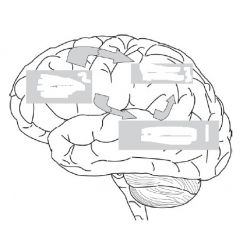
AH hallucination model. Label |
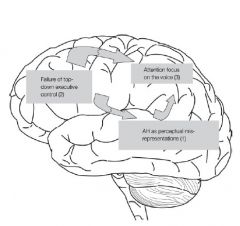
Outline of a model for auditory hallucinations (AH) as perceptual mis-representations, parietal lobe attention enhancement and failure of prefrontal executive suppression control. The model emphasizes the involvement of the middle and superior temporal gyri (1) for the generation of AH, prefrontal cortex (2) for top–down executive control, and parietal cortex (3) for attention focus. |
|
|
The integrated dopamine hypothesis of schizoprenia. High dopamine Positive symptoms Which pathway? |
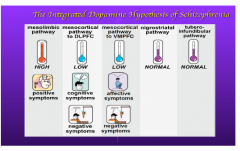
|
|
|
The integrated dopamine hypothesis of schizoprenia. Low dopamine Cognitive symptoms Negative symptoms |
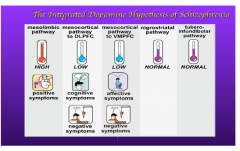
|
|
|
The integrated dopamine hypothesis of schizoprenia. Low dopamine Affective symptoms Negative symptoms |

|
|
|
The integrated dopamine hypothesis of schizoprenia. Nigrostriatal and tubero-infundibular pathyway = |

NORMAL |
|
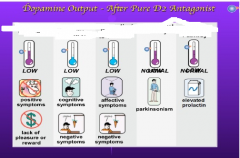
Dopamine output - After Pure D2 antagonist |
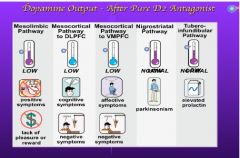
|
|
|
In terms of schizophrenia, how much later is onset for women as compared to men. |
5 years. Reason uncertain |
|
|
Positive symptoms are due to increased activity in which pathway? |
Mesolimbic DA pathway |
|
|
Negative symptoms are due to decreased activity where? |
Mesocortical pathway |
|
|
What neurotransmitter might be associated with both positive and negative symptoms of schiz? |
Glutamate |
|
|
The only evidence for the dopamine hypothesis? |
Correlation between anti-psychotic potential and affinity for blocking dopamine receptors, |
|
|
What happens if you block dopamine at the nigrostriatal pathway? |
movement disorder |
|
|
Weinburger found there is a loss of what two things in schizophrenia (discordant twin study) |
1. Loss of total volume 2. Loss of gray matter |
|
|
Where does the loss of gray matter occur in schizophrenia? |
Fronto-parietal regions |
|
|
It is now certain that schizophrenia involves structural changes to the (3)! |
1. PFC 2. coprus callosum 3. and ventricles |
|
|
Pantelis 2003. Main finding |
Gray matter reduction in psychosis. Temporal, frontal, cingulate, orbitofrontal, cerebellum. |
|
|
What is asymmetric in the schizophrenia? |
ACC |
|
|
Generally speaking, there have been two pathological processes implicated in schizophrenia. Where are they? |
Deficits in the frontal and temporal love |
|
|
TLE causes a higher tendency for what? |
Positive symptoms |
|
|
What observations have been made in the pyramidal cells in the temporal lobe? |
Disorientation of the the pyramidal cells. |
|
|
Cerebral blood flow and PET indicate what in the DLPFC during the WCST? |
Hypometabolism |
|
|
In short, both sides of the brain or their relationship to each other, the cortex and the subcortex, the temporal, frontal and parietal lobes and either underactivation or overactivation or a combination of these have been implicated in the pathogenesis of schizophrenia. |
In short, both sides of the brain or their relationship to each other, the cortex and the subcortex, the temporal, frontal and parietal lobes and either underactivation or overactivation or a combination of these have been implicated in the pathogenesis of schizophrenia. |
|
|
Deficits in attention in schizophrenia are attributable to ... |
negative symmptoms |
|
|
There is also evidence of lateralized deficits in the the ____________ and ____________ of visual attention. |
There is also evidence of lateralized deficits in the the disengagement and and redirection of visual attention. |
|
|
DSM-V criteria (5) |
Delusions 2. Hallucinations 3. Disorganised speech (i.e. frequent derailment or incoherence) 4. Grossly disorganised or catatonic behaviour 5. Negative symptoms (i.e. diminished emotional expression or avolition)
|
|
|
Hafner (1992) has reviewed the literature on prevalence and noted that the rates vary considerably as a consequence of ___________ _______________techniques |
Hafner (1992) has reviewed the literature on prevalence and noted that the rates vary considerably as a consequence of differential diagnostic techniques |
|
|
NRG1 |
Encodes for proteins with a range of synatogenesis myleination. |
|
|
DTNBP1 |
Presynaptic glutamate funciton |
|
|
DISC1 |
Neuronal migration and intracellular transport |
|
|
G30/DAO G72DAOA |
DAO activates NMDA glutamate receptor |
|
|
COMT |
Reduced frotnal task |
|
|
What percentage of patients withc schiz have very severe impairment? |
near 50% |
|
|
Agressive symptoms: (2) Positive symptoms: (1) Negative symptoms: (2) Cognitive symptoms: (1) Affective symptoms: (1) |
Agression = orbitofrontal cortex + amygdal
Positive symptoms = mesolimbic
Negative symptoms = mesocortical PFC + nucleus ambubens reward circuits
Cognitive symptoms = dorsolateral PFC
Affective symptoms = ventromedial PFC
|

